HSBC 2002 Annual Report Download - page 288
Download and view the complete annual report
Please find page 288 of the 2002 HSBC annual report below. You can navigate through the pages in the report by either clicking on the pages listed below, or by using the keyword search tool below to find specific information within the annual report.-
 1
1 -
 2
2 -
 3
3 -
 4
4 -
 5
5 -
 6
6 -
 7
7 -
 8
8 -
 9
9 -
 10
10 -
 11
11 -
 12
12 -
 13
13 -
 14
14 -
 15
15 -
 16
16 -
 17
17 -
 18
18 -
 19
19 -
 20
20 -
 21
21 -
 22
22 -
 23
23 -
 24
24 -
 25
25 -
 26
26 -
 27
27 -
 28
28 -
 29
29 -
 30
30 -
 31
31 -
 32
32 -
 33
33 -
 34
34 -
 35
35 -
 36
36 -
 37
37 -
 38
38 -
 39
39 -
 40
40 -
 41
41 -
 42
42 -
 43
43 -
 44
44 -
 45
45 -
 46
46 -
 47
47 -
 48
48 -
 49
49 -
 50
50 -
 51
51 -
 52
52 -
 53
53 -
 54
54 -
 55
55 -
 56
56 -
 57
57 -
 58
58 -
 59
59 -
 60
60 -
 61
61 -
 62
62 -
 63
63 -
 64
64 -
 65
65 -
 66
66 -
 67
67 -
 68
68 -
 69
69 -
 70
70 -
 71
71 -
 72
72 -
 73
73 -
 74
74 -
 75
75 -
 76
76 -
 77
77 -
 78
78 -
 79
79 -
 80
80 -
 81
81 -
 82
82 -
 83
83 -
 84
84 -
 85
85 -
 86
86 -
 87
87 -
 88
88 -
 89
89 -
 90
90 -
 91
91 -
 92
92 -
 93
93 -
 94
94 -
 95
95 -
 96
96 -
 97
97 -
 98
98 -
 99
99 -
 100
100 -
 101
101 -
 102
102 -
 103
103 -
 104
104 -
 105
105 -
 106
106 -
 107
107 -
 108
108 -
 109
109 -
 110
110 -
 111
111 -
 112
112 -
 113
113 -
 114
114 -
 115
115 -
 116
116 -
 117
117 -
 118
118 -
 119
119 -
 120
120 -
 121
121 -
 122
122 -
 123
123 -
 124
124 -
 125
125 -
 126
126 -
 127
127 -
 128
128 -
 129
129 -
 130
130 -
 131
131 -
 132
132 -
 133
133 -
 134
134 -
 135
135 -
 136
136 -
 137
137 -
 138
138 -
 139
139 -
 140
140 -
 141
141 -
 142
142 -
 143
143 -
 144
144 -
 145
145 -
 146
146 -
 147
147 -
 148
148 -
 149
149 -
 150
150 -
 151
151 -
 152
152 -
 153
153 -
 154
154 -
 155
155 -
 156
156 -
 157
157 -
 158
158 -
 159
159 -
 160
160 -
 161
161 -
 162
162 -
 163
163 -
 164
164 -
 165
165 -
 166
166 -
 167
167 -
 168
168 -
 169
169 -
 170
170 -
 171
171 -
 172
172 -
 173
173 -
 174
174 -
 175
175 -
 176
176 -
 177
177 -
 178
178 -
 179
179 -
 180
180 -
 181
181 -
 182
182 -
 183
183 -
 184
184 -
 185
185 -
 186
186 -
 187
187 -
 188
188 -
 189
189 -
 190
190 -
 191
191 -
 192
192 -
 193
193 -
 194
194 -
 195
195 -
 196
196 -
 197
197 -
 198
198 -
 199
199 -
 200
200 -
 201
201 -
 202
202 -
 203
203 -
 204
204 -
 205
205 -
 206
206 -
 207
207 -
 208
208 -
 209
209 -
 210
210 -
 211
211 -
 212
212 -
 213
213 -
 214
214 -
 215
215 -
 216
216 -
 217
217 -
 218
218 -
 219
219 -
 220
220 -
 221
221 -
 222
222 -
 223
223 -
 224
224 -
 225
225 -
 226
226 -
 227
227 -
 228
228 -
 229
229 -
 230
230 -
 231
231 -
 232
232 -
 233
233 -
 234
234 -
 235
235 -
 236
236 -
 237
237 -
 238
238 -
 239
239 -
 240
240 -
 241
241 -
 242
242 -
 243
243 -
 244
244 -
 245
245 -
 246
246 -
 247
247 -
 248
248 -
 249
249 -
 250
250 -
 251
251 -
 252
252 -
 253
253 -
 254
254 -
 255
255 -
 256
256 -
 257
257 -
 258
258 -
 259
259 -
 260
260 -
 261
261 -
 262
262 -
 263
263 -
 264
264 -
 265
265 -
 266
266 -
 267
267 -
 268
268 -
 269
269 -
 270
270 -
 271
271 -
 272
272 -
 273
273 -
 274
274 -
 275
275 -
 276
276 -
 277
277 -
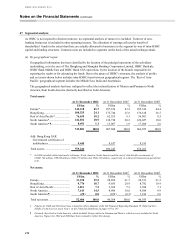 278
278 -
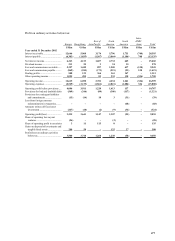 279
279 -
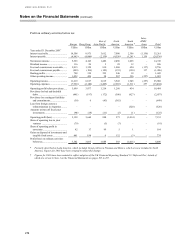 280
280 -
 281
281 -
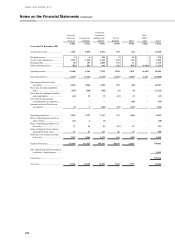 282
282 -
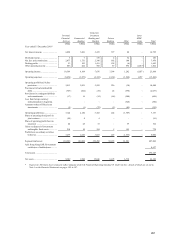 283
283 -
 284
284 -
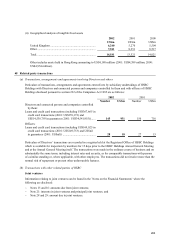 285
285 -
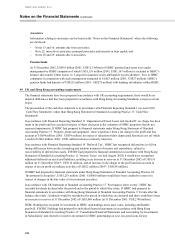 286
286 -
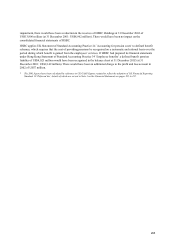 287
287 -
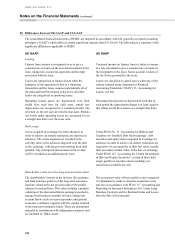 288
288 -
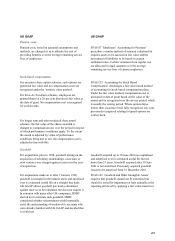 289
289 -
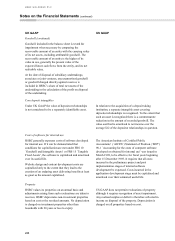 290
290 -
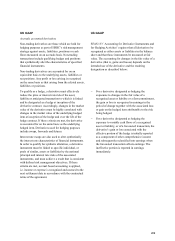 291
291 -
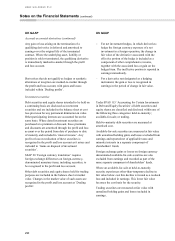 292
292 -
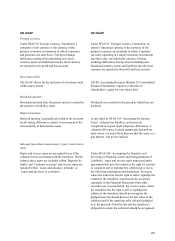 293
293 -
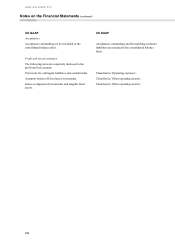 294
294 -
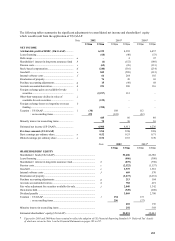 295
295 -
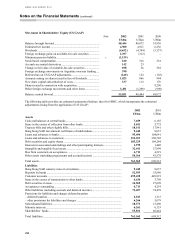 296
296 -
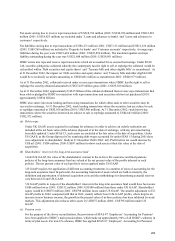 297
297 -
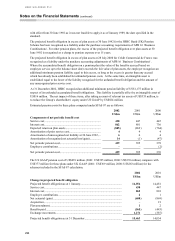 298
298 -
 299
299 -
 300
300 -
 301
301 -
 302
302 -
 303
303 -
 304
304 -
 305
305 -
 306
306 -
 307
307 -
 308
308 -
 309
309 -
 310
310 -
 311
311 -
 312
312 -
 313
313 -
 314
314 -
 315
315 -
 316
316 -
 317
317 -
 318
318 -
 319
319 -
 320
320 -
 321
321 -
 322
322 -
 323
323 -
 324
324 -
 325
325 -
 326
326 -
 327
327 -
 328
328 -
 329
329
 |
 |

HSBC HOLDINGS PLC
Notes on the Financial Statements (continued)
286
50 Differences between UK GAAP and US GAAP
The consolidated financial statements of HSBC are prepared in accordance with UK generally accepted accounting
principles (‘GAAP’ ) which differ in certain significant respects from US GAAP. The following is a summary of the
significant differences applicable to HSBC:
UK GAAP US GAAP
Leasing
Finance lease income is recognised so as to give a
constant rate of return on the net cash investment in the
lease, taking into account tax payments and receipts
associated with the lease.
Unearned income on finance leases is taken to income
at a rate calculated to give a constant rate of return on
the investment in the lease, but no account is taken of
the tax flows generated by the lease.
Leases are categorised as finance leases when the
substance of the agreement is that of a financing
transaction and the lessee assumes substantially all of
the risks and benefits relating to the asset. All other
leases are categorised as operating leases.
Leases are classified as capital leases when any of the
criteria outlined under Statement of Financial
Accounting Standards (‘SFAS’ ) 13 ‘Accounting for
Leases’ are met.
Operating leased assets are depreciated over their
useful lives such that, for each asset, rentals less
depreciation are recognised at a constant periodic rate
of return on the net cash invested in that asset. Rentals
receivable under operating leases are accounted for on
a straight-line basis over the lease term.
Operating leased assets are depreciated such that in
each period the depreciation charge is at least equal to
that which would have arisen on a straight-line basis.
Debt swaps
Assets acquired in exchange for other advances in
order to achieve an orderly realisation are reported as
advances. The assets acquired are recorded at the
carrying value of the advances disposed of at the date
of the exchange, with any provision having been duly
updated. Any subsequent deterioration in their value
will be recorded as an additional provision.
Under SFAS No. 15 ‘Accounting by Debtors and
Creditors for Troubled Debt Restructurings’ , debt
securities and equity shares acquired in exchange for
advances in order to achieve an orderly realisation are
required to be accounted for at their fair value, usually
their secondary market value, at the date of exchange.
Under SFAS 115 ‘Accounting for Certain Investments
in Debt and Equity Securities’ , certain of these debt
swaps qualify as securities and accordingly are
classified as available-for-sale.
Shareholder’s interest in the long-term assurance fund
The shareholders’ interest in the in-force life assurance
and fund pensions policies of the long-term assurance
fund are valued at the net present value of the profits
inherent in such policies. This value includes a prudent
valuation of the discounted future earnings expected to
emerge from business currently in force, taking into
account factors such as recent experience and general
economic conditions, together with the surplus retained
in the long-term assurance funds. These are determined
annually in consultation with independent actuaries and
are included in ‘Other assets’ .
The net present value of these profits is not recognised.
An adjustment is made to amortise acquisition costs
and fees in accordance with SFAS 97 ‘Accounting and
Reporting by Insurance Enterprises for Certain Long-
Duration Contracts and for Realized Gains and Losses
from the Sale of Investments’ .
